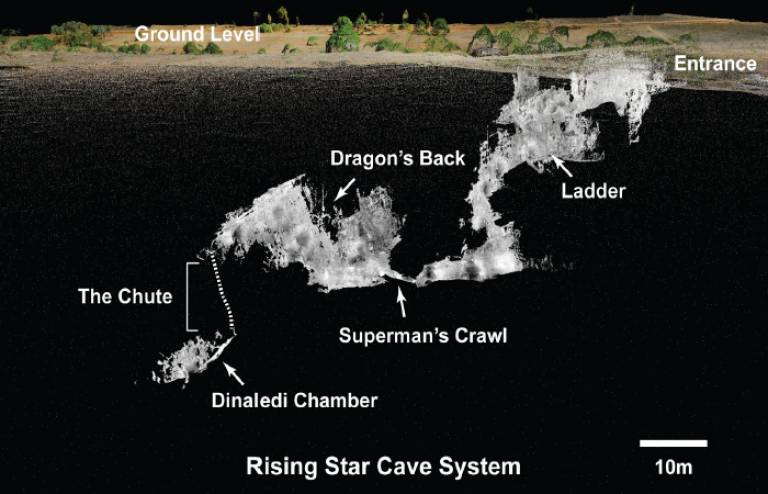Recording methodologies of the fossil hominin remains of Rising Star has finally been published
27 May 2016
The Dinaledi Chamber of the Rising Star Cave has yielded 1550 identifiable fossil elements - representing the largest single collection of fossil hominin material found on the African continent to date.
 The fossil chamber in which Homo naledi was found was accessible only through a near-vertical chute that presented immense practical and methodological limitations on the excavation and recording methods that could be used within the Cave. In response to practical challenges, a multimodal set of recording and survey methods was thus developed and employed: (1) recording of fossils and the excavation process was achieved through the use of white-light photogrammetry and laser scanning; (2) mapping of the Dinaledi Chamber was accomplished by means of high-resolution laser scanning, with scans running from the excavation site to the ground surface and the cave entrance; (3) at ground surface, the integration of conventional surveying techniques as well as photogrammetry with the use of an unmanned aerial vehicle was applied. Point cloud data were used to provide a centralised and common data structure for conversion and to corroborate the influx of different data collection methods and input formats. Data collected with these methods were applied to the excavations, mapping and surveying of the Dinaledi Chamber and the Rising Star Cave. This multimodal approach provides a comprehensive spatial framework from individual bones to landscape level.
The fossil chamber in which Homo naledi was found was accessible only through a near-vertical chute that presented immense practical and methodological limitations on the excavation and recording methods that could be used within the Cave. In response to practical challenges, a multimodal set of recording and survey methods was thus developed and employed: (1) recording of fossils and the excavation process was achieved through the use of white-light photogrammetry and laser scanning; (2) mapping of the Dinaledi Chamber was accomplished by means of high-resolution laser scanning, with scans running from the excavation site to the ground surface and the cave entrance; (3) at ground surface, the integration of conventional surveying techniques as well as photogrammetry with the use of an unmanned aerial vehicle was applied. Point cloud data were used to provide a centralised and common data structure for conversion and to corroborate the influx of different data collection methods and input formats. Data collected with these methods were applied to the excavations, mapping and surveying of the Dinaledi Chamber and the Rising Star Cave. This multimodal approach provides a comprehensive spatial framework from individual bones to landscape level.
Multimodal spatial mapping and visualisation of Dinaledi Chamber and Rising Star Cave
Ashley Kruger, Patrick S. Randolph-Quinney, Marina Elliott
DOI: http://dx.doi.org/10.17159/sajs.2016/20160032
 Close
Close

